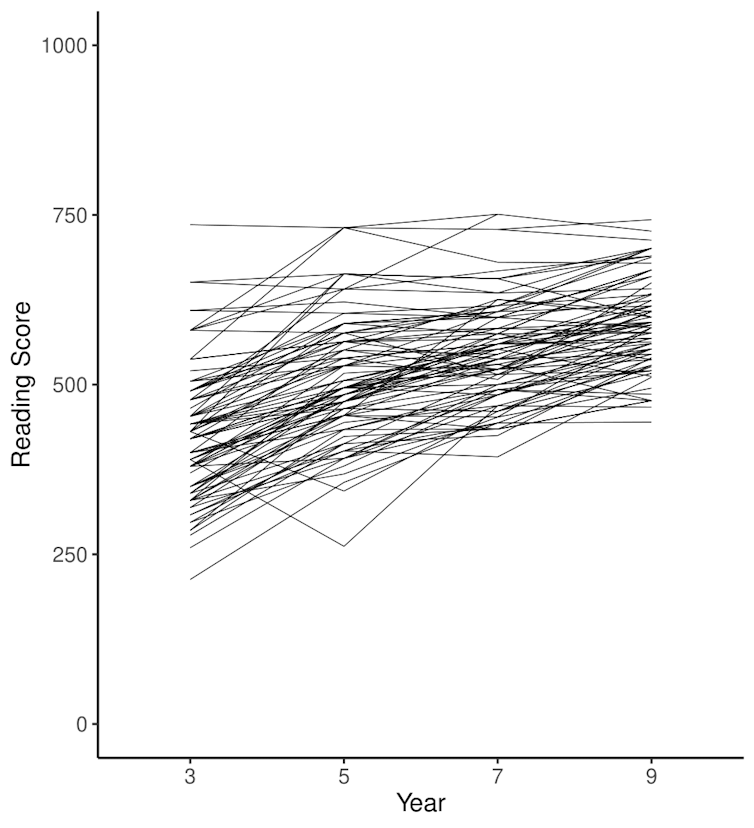
If students have poor academic results early in school, do they continue to fall further and further behind as they move through their education?
The intuitive answer to this question is yes. This perception is fuelled by relentless media reporting about falling standards in Australia, and claims about “widening gaps” between advantaged and disadvantaged groups of students.
The ‘Matthew effect’
If achievement gaps do widen as children develop, this would be evidence for what researchers call the “Matthew effect”. This theory, first described by Canadian psychologist Keith Stanovich, proposes students who start with poor academic skills early in school make less progress over time compared with their higher-achieving peers.
Referencing a verse from the Bible’s Book of Matthew, Stanovich argued children who initially had strong skills should become even stronger over time, because academic skills build on each other. (Or, as Matthew put it, “For whoever has will be given more, and they will have an abundance. Whoever does not have, even what they have will be taken from them.”).
According to this argument, higher-achieving students have an extra advantage over time because their skills, knowledge and ability will snowball, allowing their progress to accelerate relative to less able students.
But is this phenomenon universally true? Not necessarily, according to our latest research on Australian students.
Our research
We have a unique advantage in Australia because our national NAPLAN tests are designed to track students’ progress over time. So results on one test can be directly compared to the next or the previous one. This is rare internationally, and very powerful for answering questions about development.
Our research examined patterns growth in literacy and numeracy in two states. We looked at 88,958 New South Wales students (who were in Year 3 in 2012), and 65,984 students in Victoria (who were in Year 3 in 2011).
We matched NAPLAN reading comprehension and numeracy results for each student from Year 3 through to Year 9. We examined reading and numeracy, as these two skills form the basis of learning in many other areas of the curriculum.
Read more: Australia’s Year 4 students have not lost ground on reading, despite pandemic disruptions
Our findings
Contrary to expectations, we found no evidence of the Matthew effect in either reading or numeracy amongst students sitting NAPLAN tests in NSW or Victoria.
Instead, we found the reverse pattern, called “compensatory growth”.
That is, students starting with below average NAPLAN results are making more progress from Year 3 to Year 9 compared with students starting above average. This compensatory growth pattern was seen in both reading and numeracy, but was particularly strong in reading.
This pattern can be seen in the figure below which plots trajectories for 100 randomly-selected students sitting NAPLAN reading tests in NSW.
While surprising, our research aligns with findings from a 2014 meta-analysis of Matthew effects research in reading.
This earlier study examined all longitudinal research on reading development across primary school. Studies were drawn from the United States, United Kingdom, Germany, Finland, Greece, Canada, Austria, Sweden, and the Netherlands, and the combined sample included 425,685 students. Matthew effects were only observed in a quarter of the included samples.
Our research is the first in Australia to build on these findings and examine reading and numeracy development in state-wide data using individual student scores across the NAPLAN years.
Given the widespread beliefs about widening gaps, our results should be reassuring. Although, our findings also indicate the highest achieving students do not make as much growth in NAPLAN as their lower performing peers.

But what does this mean for high achievers?
There is a popular perception teachers are not effectively teaching students basic skills. But our research suggests students who begin with poorer literacy and numeracy skills are supported by classroom teachers, and do make progress over time.
However, while our results indicate poorly performing Year 3 students do “catch up” somewhat, a small proportion of students still fail to meet minimum standards for literacy and numeracy by Year 9. Ongoing efforts to identify and support these students in secondary school is vitally important.
On the other hand, our results also suggest students who begin with high achievement in NAPLAN reading and numeracy tests in Year 3 are not making the amount of progress to Year 9 they are capable of.
While both NSW and Victoria have clear policies and resources for teaching high-ability students, it is difficult for teachers to enact them if the majority of classroom time is focused on struggling students.
Perhaps the progress of high-ability students is not a high priority for schools once these students have attained the basic skills expected of their age group. Further research in Australian schools is needed to identify the reasons for underachievement relative to potential for high-ability students.
Nevertheless, our finding that struggling students can make good progress over time rather than falling further behind should be a cause for optimism among educators and the community.
Read more: A pandemic silver lining: how kids in some disadvantaged schools improved their results during COVID
Sally Larsen does not work for, consult, own shares in or receive funding from any company or organisation that would benefit from this article, and has disclosed no relevant affiliations beyond their academic appointment.
This article was originally published on The Conversation. Read the original article.







